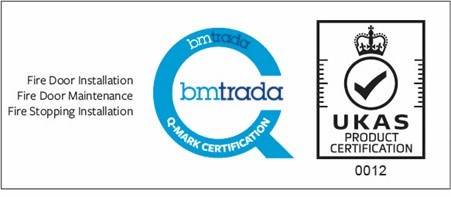AD hold the following certifications for the provision of FRA and Fire Safety Works:
BM TRADA Fire Door Maintenance
BM TRADA Fire Door Installation
BM TRADA Fire Stopping Installation
All work carried out by AD is done so in compliance with all relevant Health & Safety legislation, Approved Codes of Practice, HSE guidance (e.g. HSG168 – Fire Safety in Construction), and Building Regulations and in accordance with our ISO:9001, ISO:14001 and ISO 45001 accreditations.
AD replace door sets in accordance with the clients’ requirements and specification and manufacturers guidance/specification, ensuring required rating for location.
We are members of many accreditation and sector bodies including the Association of Specialist Fire Protection (ASFP) and we obtain regular updates on legislation, best practice and training opportunities.
AD has a number of staff certified for BM TRADA Q-Mark - Fire Door Maintenance Scheme and Fire Door Installation Scheme.
AD also have a number of approved installers for Gerda FDS complete range.
AD is certified for BM TRADA Q-Mark Fire Stopping Installation and has experience across the board in managing fire stopping and compartmentation, either through refurbishment works, or as remedial works following FRAs.

AD are affiliate members of the IFSM - Institute of Fire Safety Managers.
AD also operates a Waking Watch service.
Fire Safety Installations and Fire Remedials in the UK (FRA)
Fire safety installations and remedial works are essential components of compliance with Fire Risk Assessments (FRAs) in the UK. These installations—especially fire doors, intumescent strips, and associated passive fire protection measures—play a critical role in safeguarding lives and property in residential and commercial buildings. Under increasingly stringent regulations, including oversight from the Building Safety Regulator (BSR), ensuring correct specification, installation, and ongoing maintenance of these systems has never been more crucial.
Fire Doors and Intumescent Strips: Key Elements of Fire Safety
Fire doors are a cornerstone of passive fire protection. They are designed to compartmentalise buildings, slowing the spread of fire and smoke and providing critical time for occupants to evacuate. In line with BM TRADA standards and BS 476 / BS EN 1634, fire doors must be tested, certified, and correctly installed to perform as intended. Every detail—from the hinges and closers to the letterboxes and seals—can affect the door's performance.
Intumescent strips, often found around the perimeter of fire doors and frames, are heat-reactive materials that expand when exposed to high temperatures. This expansion seals the gap between the door and the frame, helping to contain fire and smoke. Smoke seals, often incorporated with intumescent strips, further reduce smoke migration.
A significant part of FRA-related works involves identifying non-compliant doors and upgrading or replacing them. Common issues include incorrectly specified hardware, painted-over or missing intumescent strips, and excessive gaps between the door and frame. If fire doors are not installed or maintained correctly, they fail to meet regulatory standards, risking prosecution under the Regulatory Reform (Fire Safety) Order 2005.
The Role of the Building Safety Regulator (BSR)
The introduction of the Building Safety Regulator (BSR) under the Building Safety Act 2022 has raised the bar for compliance and accountability, particularly in higher-risk buildings (HRBs). The BSR enforces stricter oversight of fire safety systems, requiring all works to demonstrate a clear “golden thread” of information from design to installation and maintenance.
For fire safety installations, this means detailed record-keeping, traceable product certification, and quality assurance through third-party schemes such as BM TRADA Q-Mark. All parties involved—from project managers to installers—must demonstrate competence under the BSR’s competence framework.